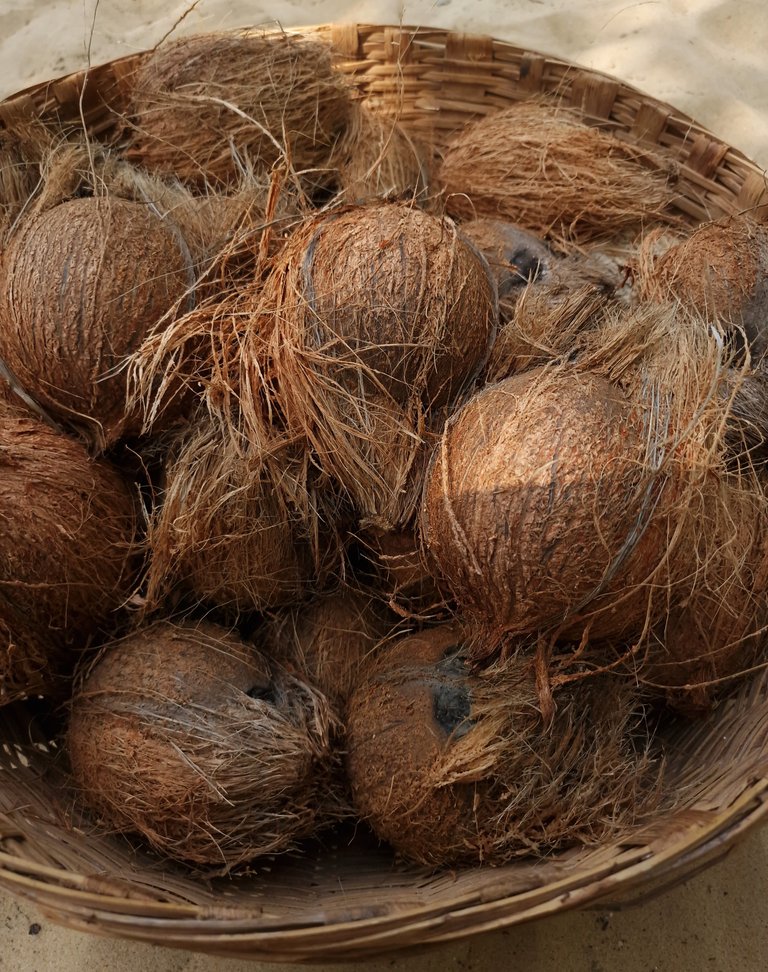
we left our garden in India back in April and since then coconuts have been ripening and many falling. we have a helper who gathered most of the fallen ones and kept them under a roof during monsoon but quite a few were left out. one of the first tasks in the garden is to gather them and peel the ones that appear to be good enough to sell, and of course a sufficient amount for for a few days' use of our own.
 before covid we used to deliver the husks to a local coir factory that made various products from the coir fiber. but they closed down during covid and never reopened. really, it was a shame to lose that endeavour. it was purely local with about 10 employees and most all the growers around here delivered their husks and were happy for the extra income. now we accumulate piles of the stuff. we use some for grilling and outdoor cooking but that is a small percentage. we give away some as firewood but still we have big piles that are just slowly rotting. our good friends, a family of mongooses had settled under one of the piles for a couple of years but we haven't seen any sign of them since we arrived.
before covid we used to deliver the husks to a local coir factory that made various products from the coir fiber. but they closed down during covid and never reopened. really, it was a shame to lose that endeavour. it was purely local with about 10 employees and most all the growers around here delivered their husks and were happy for the extra income. now we accumulate piles of the stuff. we use some for grilling and outdoor cooking but that is a small percentage. we give away some as firewood but still we have big piles that are just slowly rotting. our good friends, a family of mongooses had settled under one of the piles for a couple of years but we haven't seen any sign of them since we arrived.

inevitably a few of the ripe coconuts that we peeled had sprouted. most likely they were left out in the monsoon rain for a while before they were gathered and put under the roof. they are not good for eating but can be milled for lamp oil or they can be planted. we don't need any oil so i chose to plant them

there are also a few scattered around outside that have sprouted and grown roots. it's great that they have done so but they are too close to the mother tree and we cannot let them grow there . we could just pull them up and discard them but i want to move them together to an open area and plant them for a few years before we either place them permanently or sell them as plants. the challenge is digging them up without damaging their tender roots as well as the dense roots of the mother tree.

the way i have developed to achieve this is to take the garden hose/pipe and let the water do the digging in the sand. i simply push the hose along the roots and the sand loosens fairly easily.

i use the same technique to dig up weed trees like the invasive acacia that the birds spread all around. each year we pull up a couple hundred seedlings but they grow so fast that if we miss any they are impossible to pull up the second year
 here the coconut is free with the roots in tact. the roots of the mother tree have also loosened where the hole is but they have been watered and will not suffer any damage.
here the coconut is free with the roots in tact. the roots of the mother tree have also loosened where the hole is but they have been watered and will not suffer any damage.

then i soak both the 4 peeled and 7 unpeeled ones in a barrel of shallow water for a few hours before i prepare the plot where i shall plant them. the plot should be sunny and easily accessible for frequent watering. even though the soil is pure sand there a good chance all 11 will grow nicely as long as they get watered regularly.

i cleared about 8 square meters next to our compost pit where there was dry grass and mixed in just a little wood ash to deter the termites. the first coconut is now in place.

here all 11 are planted. the sand is dry so it will take a lot of water to soak down 30 cm to the tips of the deepest roots. the peeled coconuts are much shallower. i sloped the surfaced so the deepest roots get the most water. this shot is after the first watering. it doesn't look like much yet but in a couple of days and several more waterings i'll smooth it over and fix the border and it should look much better.

when that job was finished i went up on the terrace to enjoy the sun setting behind our mature trees

thanks for joining me

 )
)
